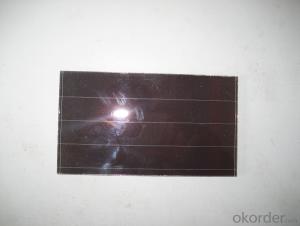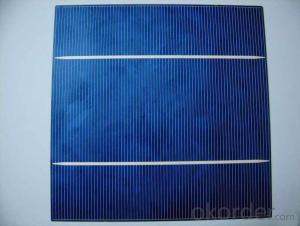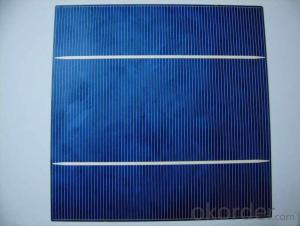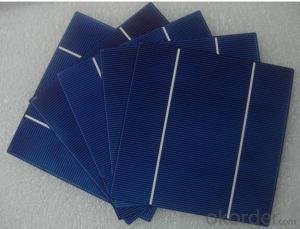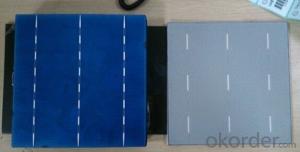Solar Cell High Quality A Grade Cell Polyrystalline 5v 15.8%
- Loading Port:
- Shanghai
- Payment Terms:
- TT OR LC
- Min Order Qty:
- 1000 pc
- Supply Capability:
- 100000 pc/month
OKorder Service Pledge
OKorder Financial Service
You Might Also Like
Specifications
hot sale solar cell
1.16.8%~18.25% high efficiency
2.100% checked quality
3.ISO9001/ISO14001/TUV/CE/UL
4.stable performance
We can offer you the best quality products and services, don't miss !
POLY6'(156*156)
Polycrystalline Silicon Solar cell
Physical Characteristics
Dimension: 156mm×156mm±0.5mm
Diagonal: 220mm±0.5mm
Thickness(Si): 200±20 μm
Front(-) Back(+)
Blue anti-reflecting coating (silicon nitride); Aluminum back surface field;
1.5mm wide bus bars; 2.0mm wide soldering pads;
Distance between bus bars: 51mm . Distance between bus bars :51mm .
Electrical Characteristics
Efficiency(%) | 18.00 | 17.80 | 17.60 | 17.40 | 17.20 | 16.80 | 16.60 | 16.40 | 16.20 | 16.00 | 15.80 | 15.60 |
Pmpp(W) | 4.33 | 4.29 | 4.24 | 4.19 | 4.14 | 4.09 | 4.04 | 3.99 | 3.94 | 3.90 | 3.86 | 3.82 |
Umpp(V) | 0.530 | 0.527 | 0.524 | 0.521 | 0.518 | 0.516 | 0.514 | 0.511 | 0.509 | 0.506 | 0.503 | 0.501 |
Impp(A) | 8.159 | 8.126 | 8.081 | 8.035 | 7.990 | 7.938 | 7.876 | 7.813 | 7.754 | 7.698 | 7.642 | 7.586 |
Uoc(V) | 0.633 | 0.631 | 0.628 | 0.625 | 0.623 | 0.620 | 0.618 | 0.617 | 0.615 | 0.613 | 0.611 | 0.609 |
Isc(A) | 8.709 | 8.677 | 8.629 | 8.578 | 8.531 | 8.478 | 8.419 | 8.356 | 8.289 | 8.220 | 8.151 | 8.083 |
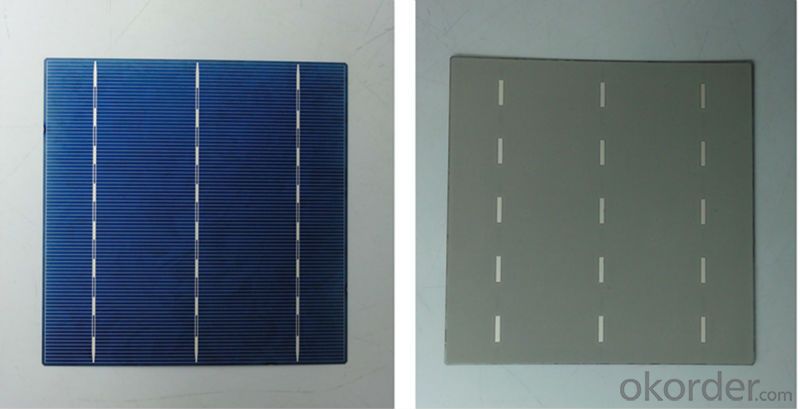
MONO5'(125*125mm)165
Monocrystalline silicon solar cell
Physical Characteristics
Dimension: 125mm×125mm±0.5mm
Diagonal: 165mm±0.5mm
Thickness(Si): 200±20 μm
Front(-) Back(+)
Blue anti-reflecting coating(silicon nitride); Aluminum back surface field;
1.6mmwide bus bars; 2.5mm wide soldering pads;
Distance between bus bars: 61mm . Distance between bus bars :61mm .
Electrical Characteristics
Efficiency(%) | 19.40 | 19.20 | 19.00 | 18.80 | 18.60 | 18.40 | 18.20 | 18.00 | 17.80 | 17.60 | 17.40 | 17.20 |
Pmpp(W) | 2.97 | 2.94 | 2.91 | 2.88 | 2.85 | 2.82 | 2.79 | 2.76 | 2.73 | 2.70 | 2.67 | 2.62 |
Umpp(V) | 0.537 | 0.535 | 0.533 | 0.531 | 0.527 | 0.524 | 0.521 | 0.518 | 0.516 | 0.515 | 0.513 | 0.509 |
Impp(A) | 5.531 | 5.495 | 5.460 | 5.424 | 5.408 | 5.382 | 5.355 | 5.328 | 5.291 | 5.243 | 5.195 | 4.147 |
Uoc(V) | 0.637 | 0.637 | 0.636 | 0.635 | 0.633 | 0.630 | 0.629 | 0.629 | 0.628 | 0.626 | 0.626 | 0.625 |
Isc(A) | 5.888 | 5.876 | 5.862 | 5.848 | 5.839 | 5.826 | 5.809 | 5.791 | 5.779 | 5.756 | 5.293 | 5.144 |

FAQ:
Q:How can i get some sample?
A:Yes , if you want order ,sample is not a problem.
Q:How about your solar panel efficency?
A: Our product efficency around 17.25%~18.25%.
Q:What’s the certificate you have got?
A: we have overall product certificate of ISO9001/ISO14001/CE/TUV/UL
- Q:How much does a solar silicon wafer weigh?
- A solar silicon wafer typically weighs around 4 to 6 grams. However, the weight can vary depending on the size and thickness of the wafer.
- Q:What is the impact of wafer surface quality on solar silicon wafer performance?
- The impact of wafer surface quality on solar silicon wafer performance is significant. A high-quality wafer surface ensures better light absorption and reduces energy loss due to reflections. It also helps in improving the efficiency of solar cells by minimizing recombination and enhancing charge carrier collection. Additionally, a smooth and defect-free surface enables better adhesion and electrical contact during the manufacturing process, leading to more reliable and durable solar panels.
- Q:How does the doping process affect the performance of a solar silicon wafer?
- The doping process significantly affects the performance of a solar silicon wafer. Doping involves introducing impurities into the silicon crystal lattice to alter its electrical properties. By adding specific elements like boron or phosphorus, the wafer's conductivity can be controlled, enabling the efficient movement of charge carriers. This helps in the creation of p-n junctions, essential for solar cell operation. Doping also enhances the wafer's ability to absorb light, resulting in improved conversion of sunlight into electricity. Overall, the doping process plays a crucial role in optimizing the performance and efficiency of a solar silicon wafer.
- Q:Can solar silicon wafers be recycled?
- Yes, solar silicon wafers can be recycled. The recycling process involves the extraction and purification of silicon from used wafers, which can then be used to manufacture new solar panels. Recycling solar silicon wafers helps reduce waste and promotes a more sustainable approach to solar energy production.
- Q:How are solar silicon wafers inspected for surface defects?
- Solar silicon wafers are inspected for surface defects through a combination of visual inspection, automated optical inspection systems, and manual scanning techniques. These methods help identify any imperfections such as scratches, cracks, or contaminants on the wafer's surface.
- Q:What is the impact of wafer thickness on solar silicon wafer performance?
- The impact of wafer thickness on solar silicon wafer performance is significant. Thicker wafers tend to have higher mechanical strength and better resistance to cracking, making them more durable during handling and installation. However, thicker wafers also have higher light absorption, leading to increased optical losses and reduced overall efficiency. On the other hand, thinner wafers have lower light absorption losses but are more prone to breakage, especially during fabrication and handling processes. Therefore, finding an optimal balance between wafer thickness and performance is crucial for maximizing solar cell efficiency and ensuring cost-effectiveness in the solar industry.
- Q:What is the price of monocrystalline silicon
- On a large grain of silicon, 160 thousand transistors can be integrated. What a fine project! This is the crystallization of multidisciplinary collaborative efforts, is another milestone in the progress of science and technology.
- Q:What is the typical shelf life of a solar silicon wafer?
- The typical shelf life of a solar silicon wafer can vary depending on storage conditions, but it is generally expected to be around 1 to 2 years.
- Q:Can solar silicon wafers be used in portable solar chargers?
- Yes, solar silicon wafers can be used in portable solar chargers. These wafers are commonly used in the production of solar cells, which are the key component of solar chargers. The silicon wafers help convert sunlight into electricity, making them an essential part of portable solar chargers that harness solar energy to charge devices on the go.
- Q:How are solar silicon wafers tested for electrical properties?
- Solar silicon wafers are tested for electrical properties using various methods such as sheet resistance measurement, open-circuit voltage measurement, and dark current measurement. These tests help determine the conductivity, efficiency, and overall performance of the solar wafers.
1. Manufacturer Overview |
|
|---|---|
| Location | |
| Year Established | |
| Annual Output Value | |
| Main Markets | |
| Company Certifications | |
2. Manufacturer Certificates |
|
|---|---|
| a) Certification Name | |
| Range | |
| Reference | |
| Validity Period | |
3. Manufacturer Capability |
|
|---|---|
| a)Trade Capacity | |
| Nearest Port | |
| Export Percentage | |
| No.of Employees in Trade Department | |
| Language Spoken: | |
| b)Factory Information | |
| Factory Size: | |
| No. of Production Lines | |
| Contract Manufacturing | |
| Product Price Range | |
Send your message to us
Solar Cell High Quality A Grade Cell Polyrystalline 5v 15.8%
- Loading Port:
- Shanghai
- Payment Terms:
- TT OR LC
- Min Order Qty:
- 1000 pc
- Supply Capability:
- 100000 pc/month
OKorder Service Pledge
OKorder Financial Service
Similar products
New products
Hot products
Related keywords





















